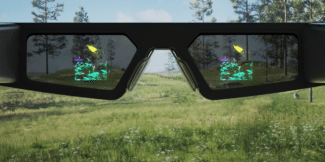Snap is working on next generation AR Spectacles, but seemingly still only for developers.
In an all-hands memo leaked to The Verge and confirmed by a Snap spokesperson, CEO Evan Spiegel outlined the company’s current challenges and future plans. Here’s how Spiegel described Snap’s strategic interest in augmented reality:
Leadership in augmented reality is important to Snap because it helps us build a durable competitive advantage that comes from investing over the long term, building things that are technically difficult, and growing a platform that is increasingly hard to replicate. It also positions us to benefit from the next major platform shift: mobile to wearables. Leading this shift will be one of our most meaningful contributions to human progress; empowering people to express themselves, live in the moment, learn about the world, and have fun together.
And here’s what he said about Snap’s plans for Spectacles:
We will continue to invest in Spectacles, making long term bets on new technology and executing against the design for our next generation product. We will help developers confidentially explore the possibilities that are enabled with our next-generation device, and integrate that feedback into SnapOS and Lens Studio. We will work hard to align the work of the Camera Platform team with SnapOS and SnapLab hardware, making sure that we are able to deliver a high-quality product that delights developers with its ease of use and advanced technical capabilities.
The current generation Spectacles was revealed over a year ago. It’s a standalone device with two cameras to perform spatial tracking of the world as well as hand tracking and video capture. It reaches an impressive 2000 nits of brightness, making it one of the only AR devices usable outdoors. However, the field of view is a tiny 26.3 degrees diagonal and the battery lasts just 30 minutes.
It isn’t a product you can buy. It’s available to developers who successfully apply. And based on Spiegel’s memo, it seems like the next generation AR-capable Spectacles will follow the same strategy – at least initially.

Last week Spiegel announced Snap is “refocusing”, laying off 20% of its staff and cancelling multiple products including its handheld drone. The move was a response to a dramatic 85% crash of Snap’s share price over the past year, driven by the fall in advertising demand across the economy and Apple’s iOS privacy changes reducing the effectiveness of targeting. This included multiple layoffs of employees working on augmented reality, raising the prospect that Snap may not prioritize AR in the short term.
In its monthly financial update Snap told investors “we’re narrowing our investment scope in Spectacles to focus on highly differentiated long-term research and development efforts”. Snap’s R&D includes brain reading following its acquisition of NextMind earlier this year, and AR waveguides & projectors following its acquisition of WaveOptics last year.

Spiegel’s mention of a next generation device shows Snap is still working on nearer term AR hardware, but a consumer launch doesn’t sound imminent. Meta, which has also been affected by weakening advertising demand and iOS privacy changes, reportedly canceled its own plans to launch consumer AR glasses in 2024, pushing the target back to 2026. Reports have claimed Apple has also pushed plans for AR glasses to the second half of the decade.
But the memo makes clear that Spiegel’s core commitment to the future of AR still remains. His acknowledgement of “the next major platform shift: mobile to wearables” mirrors the language of Mark Zuckerberg, the only big tech CEO essentially betting their entire company on this assumed coming shift in the consumer tech paradigm. Spiegel sees this work as “one of our most meaningful contributions to human progress”, and wants Snap to be a leader in the field.




